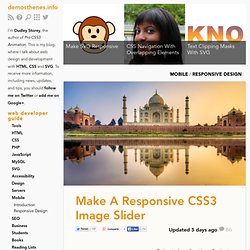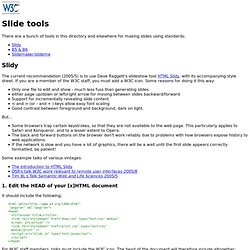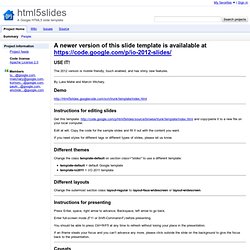

Make A Responsive CSS3 Image Slider. Previously, I’ve demonstrated how to make a fixed-width CSS image slider.

Increasingly, web developers desire solutions that not only scale across viewport sizes, but perform well on mobile devices. The responsive solution detailed here is particularly well-suited to those goals, as it avoids JavaScript entirely, running purely in CSS (and thus faster, smoother, and with less overhead). The idea is very similar to the previous example: an “imagestrip” containing all the photographs of our slider moving inside a window element which works to restrict the visibility of elements outside it. For this example, you’ll need four images, although in practice you could make a strip with as many images as you wished.
The sole condition is that all the images must be exactly the same size. Create A Responsive Frame With An Imagestrip First, we need to make the outer slider element responsive. In our CSS, the width of the figure is described as a percentage multiplier of the div that contains it. MSchmidt/jquery-fullsizable. Prezi Alternatives and Similar Software. Presentation tool based on the power of CSS3 transforms and transitions in modern browsers. Web-based slideshow. A Web-based slideshow is a slide show which can be played (viewed or presented) using a web browser.

Some web based slide shows are generated from presentation software and may be difficult to change (they are usually not supposed to). Others offer templates allowing the slide show to be easily edited and changed. Compared to a fully fledged presentation program the web based slide shows are usually limited in features. A web based slide show is typically generated to or authored in HTML, JavaScript and CSS code (files). Features[edit] Player/Presentation Features[edit] Editor Features[edit] Theme and styling supportCan embed imagesCan embed videos and audio and other multimediaSupports master pages/templates for slidesEmbedding SVGEmbedding MathMLEmbedding other web pages.
HTML Slidy (1) Copyright © 2005-2010 W3C ® (MIT, ERCIM, Keio), All Rights Reserved.

For handouts, its often useful to include extra notes using a div element with class="handout" following each slide, as in: <div class="slide"> ... your slide content ... </div><div class="handout"> ... stuff that only appears in the handouts ... </div> C Slide show Tools. There are a bunch of tools in this directory and elsewhere for making slides using standards: Slidy The current recommendation (2005/5) is to use Dave Raggett's slideshow tool HTML Slidy, with its accompanying style sheet.

If you are a member of the W3C staff, you must add a W3C icon. Some reasons for doing it this way: Only one file to edit and show - much less fuss than generating slides either page up/down or left/right arrow for moving between slides backward/forward Support for incrementally revealing slide content < and > (or - and + ) keys allow easy font scaling Good contrast between foreground and background, dark on light. HTML5 Presentation. In March 1936, an unusual confluence of forces occurred in Santa Clara County.

A long cold winter delayed the blossoming of the millions of cherry, apricot, peach, and prune plum trees covering hundreds of square miles of the Valley floor. Then, unlike many years, the rains that followed were light and too early to knock the blossoms from their branches. Instead, by the billions, they all burst open at once. Seemingly overnight, the ocean of green that was the Valley turned into a low, soft, dizzyingly perfumed cloud of pink and white. Uncounted bees and yellow jackets, newly born, raced out of their hives and holes, overwhelmed by this impossible banquet.
Then came the wind. It roared off the Pacific Ocean, through the nearly uninhabited passes of the Santa Cruz Mountains and then, flattening out, poured down into the great alluvial plains of the Valley. Html5slides - A Google HTML5 slide template. The 2012 version is mobile friendly, touch enabled, and has shiny new features.

By Luke Mahé and Marcin Wichary. Demo Instructions for editing slides Get this template: and copy/paste it to a new file on your local computer. Edit at will. If you need styles for different tags or different types of slides, please let us know. Different themes Change the class template-default on section class="slides" to use a different template: template-default = default Google template template-io2011 = I/O 2011 template Different layouts Change the outermost section class layout-regular to layout-faux-widescreen or layout-widescreen. Instructions for presenting Press Enter, space, right arrow to advance; Backspace, left arrow to go back. Enter full-screen mode (F11 or Shift-Command-F) before presenting. You should be able to press Ctrl+R/F5 at any time to refresh without losing your place in the presentation. Caveats.